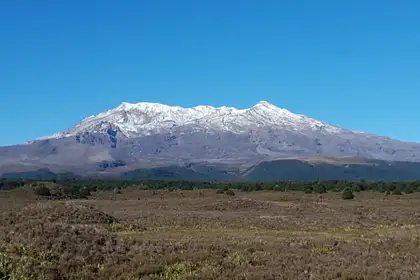
Ruapehu Volcano.
The 100 sites receive recognition because they are deemed to be of high scientific value and the world’s greatest demonstrations of geologic features and processes. Recognition on the list can lead to further appreciation of their educational resources and preservation.
More than 700 experts from 80 countries took part in the collation of the list. Rotorua’s geothermal fields, Ruapehu Volcano, the Muriwai megapillow lava flows, the towering sea cliffs of Fiordland and Maruia Falls all feature on the list.
Ruapehu Volcano was nominated by the Volcanic Risk Solutions group at Te Kunenga ki Pūrehuroa Massey University.
Member of the Volcanic Risk Solutions group Professor Jonathan Procter says having Ruapehu Volcano recognised aligns nicely with the cultural and biodiversity world heritage status the area has.
“Ruapehu or Te Matua o te Mana is an important volcano contributing to our scientific understanding of volcanic processes worldwide. The volcano is also iconic and shaped much of our cultural connections to our unique Aotearoa landscape, which is important to have recognised internationally.”
Ruapehu Volcano is recognised as an iconic and active stratovolcano, a typical volcano produced along a convergent plate boundary. This stratovolcano is at the southern end of the western arm of the Pacific Ring of Fire and has been erupting in regular intervals over the past 200,000 years.
Its lava chemistries have been studied in great detail, providing insight into the processes occurring at depth. There have been studies on the periodic eruptions from the crater lake (Te Wai-ā-Moe) at the summit, and on the flow mechanisms of lahars flowing down the volcano from the hot lake.
As a result, Ruapehu Volcano is an internationally recognised model of andesitic volcanism and is a major part of the Tongariro National Park World Heritage Area.
The International Union of Geological Sciences noted that this volcanic plateau has internationally unique endemic species, intrinsically linked to the geological and geothermal processes occurring in the region, which has a dual UNESCO World Heritage Status for its biodiversity.
Ruapehu Volcano lies within Tongariro National Park, which is New Zealand's oldest national park. This status recognises the park's important Māori cultural and spiritual associations for the Tūwharetoa and Ngāti Rangi iwi, as well as its outstanding volcanic features.
Related news
Academic appointed Editor-in-Chief of the Journal of Applied Volcanology
Dr Emma Hudson-Doyle has been announced as the new Editor-in-Chief of the prestigious international Journal of Applied Volcanology.

Hunga Volcano eruption and its once-in-a-century atmospheric wave
Hunga Volcano in the Kingdom of Tonga began a new eruptive sequence on 19 December 2021, culminating in the climactic eruption on 15 January 2022.

Modelling volcanoes that “collapse without warning”
A new joint-research project from Massey University, University of Canterbury and GNS Science is looking to forecast, for the first time, the hazards associated with collapsing volcanoes, that could save infrastructure and lives.
